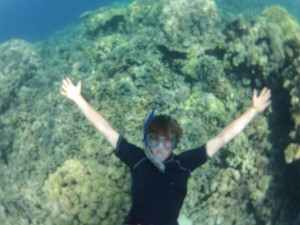By Taylor Schultz, Ka’u Program Supervisor
 Students recently had the opportunity to visit Pu’uhonua o Hōnaunau, a National Historical Park that preserves parts of traditional Hawaiian life. The park sits in Hōnaunau Bay which is a popular snorkeling destination today. This bay once provided a sheltered canoe landing and fresh drinking water for the ali’i or royal chiefs and they set up one of their most important residences here. As an extra highlight, this was also the day of the 27th annual Calvin Kelekolio Long Distance Canoe Race starting and finishing in Hōnaunau Bay. In this race the Junior teams raced 2 miles, the Women and Mixed teams 8 miles, and the Mens teams 13 miles. Students joined the crowd in cheering the canoes on as they raced to the finish line.
Students recently had the opportunity to visit Pu’uhonua o Hōnaunau, a National Historical Park that preserves parts of traditional Hawaiian life. The park sits in Hōnaunau Bay which is a popular snorkeling destination today. This bay once provided a sheltered canoe landing and fresh drinking water for the ali’i or royal chiefs and they set up one of their most important residences here. As an extra highlight, this was also the day of the 27th annual Calvin Kelekolio Long Distance Canoe Race starting and finishing in Hōnaunau Bay. In this race the Junior teams raced 2 miles, the Women and Mixed teams 8 miles, and the Mens teams 13 miles. Students joined the crowd in cheering the canoes on as they raced to the finish line.
The students thoroughly enjoyed soaking up the sun and playing in the water before heading back to the park to explore the royal grounds and the place of refuge. The place of refuge is separated from the royal grounds by a 17 ft thick, 10 ft high stone wall that was built around 1550. This was a refuge for defeated warriors, noncombatants in time of war, and for those who violated kapu, the sacred laws. During war, the object of battle was to obliterate the enemy. This included everyone from those too old, too young, or unable to fight to defeated warriors who would seek sanctuary here until the fighting was over. Tradition held that the ali’i possessed mana or spiritual power and their bones would be placed in a heiau, a Hawaiian temple, within pu’uhonua. It was the presence and mana of these bones that protected the sanctuary and gave those seeking it a second chance.
Everyone was tired from the snorkeling and swimming, so after the half mile walk through the royal grounds and pu’uhonua, the group refilled their water bottles and loaded up into the car to head back to camp. Conversation was light and sporadic on the drive as everyone watched the landscape change and reflected on their day.
Exploring Pu’uhonua o Hōnaunau
By Taylor Schultz, Ka’u Program Supervisor Students recently had the opportunity to visit Pu’uhonua o Hōnaunau, a National Historical Park that preserves parts of traditional Hawaiian life. The park sits in Hōnaunau Bay which is a popular snorkeling destination today. This bay once provided a sheltered canoe landing and fresh drinking water for the ali’i …
By Taylor Schultz, Ka’u Program Supervisor
The students thoroughly enjoyed soaking up the sun and playing in the water before heading back to the park to explore the royal grounds and the place of refuge. The place of refuge is separated from the royal grounds by a 17 ft thick, 10 ft high stone wall that was built around 1550. This was a refuge for defeated warriors, noncombatants in time of war, and for those who violated kapu, the sacred laws. During war, the object of battle was to obliterate the enemy. This included everyone from those too old, too young, or unable to fight to defeated warriors who would seek sanctuary here until the fighting was over. Tradition held that the ali’i possessed mana or spiritual power and their bones would be placed in a heiau, a Hawaiian temple, within pu’uhonua. It was the presence and mana of these bones that protected the sanctuary and gave those seeking it a second chance.
Everyone was tired from the snorkeling and swimming, so after the half mile walk through the royal grounds and pu’uhonua, the group refilled their water bottles and loaded up into the car to head back to camp. Conversation was light and sporadic on the drive as everyone watched the landscape change and reflected on their day.
Questions? Call or Text our Admissions Team: 808-937-5806